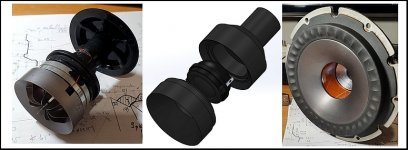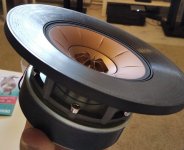I'd always go for 2xSW10.8 AC than 2xSB's - but that's just me.
Loudspeaker shop | REDCATT SW10.8 AC | DIY
As Martin pointed out already, I mainly interested in 8" woofers for this woofer-coax-woofer design, which was stimulated by your project by the way. Thank you for that. Would you mind telling which woofers you are using in your speakers? They are going to be ported, right?
I'm using 7" woofers.
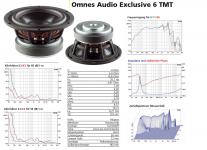
There are few reasons i'm using 7" instead of 10" woofers but mainly to keep the cabinets as narrow as i can. Printing a shadow flare is quite doable and cheap and it ensures that diffraction remains low. Going ported enables the cabinet to go as low as i want without too much trouble. 7" woofer is not much but i've found the ones with largest motors that i could (50mm voice coils, large magnets), highest Xmax that i could, that will get me down to lower 40's at what i consider a reasonable cost.
If i had more money and ability to print the front baffle - i'd deffinitely go with larger woofers and closed cabinets.
As you have shown, designing entire baffle allows you to better controll the diffraction and controll the directivity lower.
The 10's i linked are reasonably priced and perform quite well in small closed cabinets with substantial Xmax capabilities. SB MFC are good but i try to stay away from plastic cones. Not that it will ever be a problem since you will be using them just for bass.

There are few reasons i'm using 7" instead of 10" woofers but mainly to keep the cabinets as narrow as i can. Printing a shadow flare is quite doable and cheap and it ensures that diffraction remains low. Going ported enables the cabinet to go as low as i want without too much trouble. 7" woofer is not much but i've found the ones with largest motors that i could (50mm voice coils, large magnets), highest Xmax that i could, that will get me down to lower 40's at what i consider a reasonable cost.
If i had more money and ability to print the front baffle - i'd deffinitely go with larger woofers and closed cabinets.
As you have shown, designing entire baffle allows you to better controll the diffraction and controll the directivity lower.
The 10's i linked are reasonably priced and perform quite well in small closed cabinets with substantial Xmax capabilities. SB MFC are good but i try to stay away from plastic cones. Not that it will ever be a problem since you will be using them just for bass.
I'm using 7" woofers.
View attachment 1001325
There are few reasons i'm using 7" instead of 10" woofers but mainly to keep the cabinets as narrow as i can. Printing a shadow flare is quite doable and cheap and it ensures that diffraction remains low. Going ported enables the cabinet to go as low as i want without too much trouble. 7" woofer is not much but i've found the ones with largest motors that i could (50mm voice coils, large magnets), highest Xmax that i could, that will get me down to lower 40's at what i consider a reasonable cost.
If i had more money and ability to print the front baffle - i'd deffinitely go with larger woofers and closed cabinets.
As you have shown, designing entire baffle allows you to better controll the diffraction and controll the directivity lower.
The 10's i linked are reasonably priced and perform quite well in small closed cabinets with substantial Xmax capabilities. SB MFC are good but i try to stay away from plastic cones. Not that it will ever be a problem since you will be using them just for bass.
Seems like a very nice plan. I'm looking forward to your measurements and listening impressions!
I'd always go for 2xSW10.8 AC than 2xSB's - but that's just me.
Loudspeaker shop | REDCATT SW10.8 AC | DIY
This seems to be sold out and I can't find it on REDCATT webpage. Perhaps it's been replaced by 10FHW, which is 4 ohm but otherwise very similar to SW10.8. They both seem nice more affordable alternatives for L26ROY. If only there was something like this in 8". The SB MFC is best compromise I have been able to find so far. Then there's Dayton RSS210HO, which is more expensive (in EU), but I'm not convinced it's any better than the SBs. Wavecor has some models which should also work nicely in a small sealed box, but they too expensive for 4x8". There would be much more options if I would double the budget or the enclosure size...
Last edited:
Seems like a very nice plan. I'm looking forward to your measurements and listening impressions!...
I have few pics and measurements but didn't want to hijack your thread but since you've asked 🙂 ...
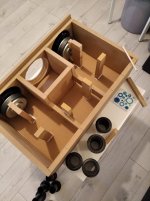
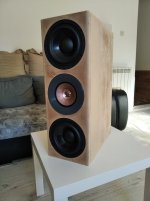
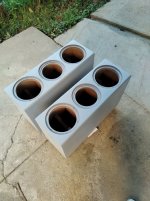
Internal struts are done. Cabinet has been coated with 3 layers of boat varnish inside and out to seal the mdf and prevent it from absorbing any air moisture. Then it was sanded with 120 grit paper and sprayed with some spray putty. If it sounds right, it will get thorough finish it deserves. On the pics flare is just there to see how it will look but will be attached by 4-6 pieces of nd magnets.
Midrange 0-90 degrees in 10 deg increments
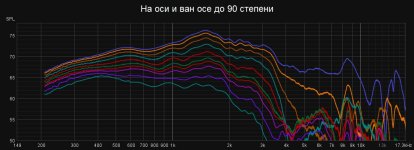
Tweeter 0-90 degrees in 10 deg increments
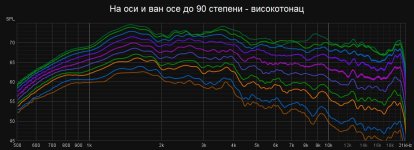
On axis some diffraction products are visible. My guess is that it origins from tangerine phase plug. It is very mild though and tangerine waveguide enables it to have such a great off axis response above 10kHz. Here are the same tweeter measurements but without on axis measurement:
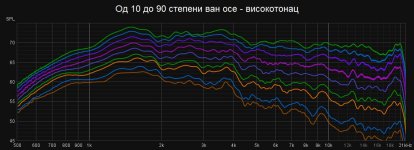
Impulse responses for midrange and tweeter
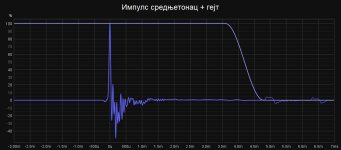
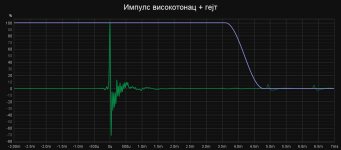
I must say that it behaves beautifully. No aberations and quite consistent response that should make designing a passive crossover between midrange and tweeter easy. Midrange also behaves like a dream from 200Hz up to 3.5kHz. Next step - basketball hall to lift the speakers 3 meters from the ground and make some high resolution measurements for crossover design.
....This seems to be sold out and I can't find it on REDCATT webpage. Perhaps it's been replaced by 10FHW, which is 4 ohm but otherwise very similar to SW10.8. They both seem nice more affordable alternatives for L26ROY. If only there was something like this in 8". The SB MFC is best compromise I have been able to find so far. Then there's Dayton RSS210HO, which is more expensive (in EU), but I'm not convinced it's any better than the SBs. Wavecor has some models which should also work nicely in a small sealed box, but they too expensive for 4x8". There would be much more options if I would double the budget or the enclosure size...
I totally agree on all accounts. RSS210 is just to expensive in Europe. Wavecor pushes the price tag ever more for almost the same performance. If 8" diameter is fixed and price of 125 euros a piece is upper limit, there is no better sub than SB23MFCL that i'm aware of.
Last edited:
I don't think this is hijacking by any means. I think we can all agree that your project is so closely related that all details and results are relevant to this thread. Personally I find it both inspirational and motivational. The responses look very nice indeed! Some small diffraction features in the on-axis response are probably nothing to worry about. As far as I have understood, these coaxial speakers are often designed to be listened ~20 degrees off axis with very little or no toe in, or alternatively with an aggressive toe in as recommended by Geddes.
By the way, I my measurements show some diffraction features at 8kHz, which I though are resulting from a slight axial misalignment between the cone and the fixed part of the tweeter waveguide around the Tangerine waveguide. There's a small step between the cone and the center part in in the Q100 driver (which could be compensated with a small DC offset voltage ). How does it look in the R-series UniQ driver?
). How does it look in the R-series UniQ driver?
Edit: See Erin's measurements with larger DC offset
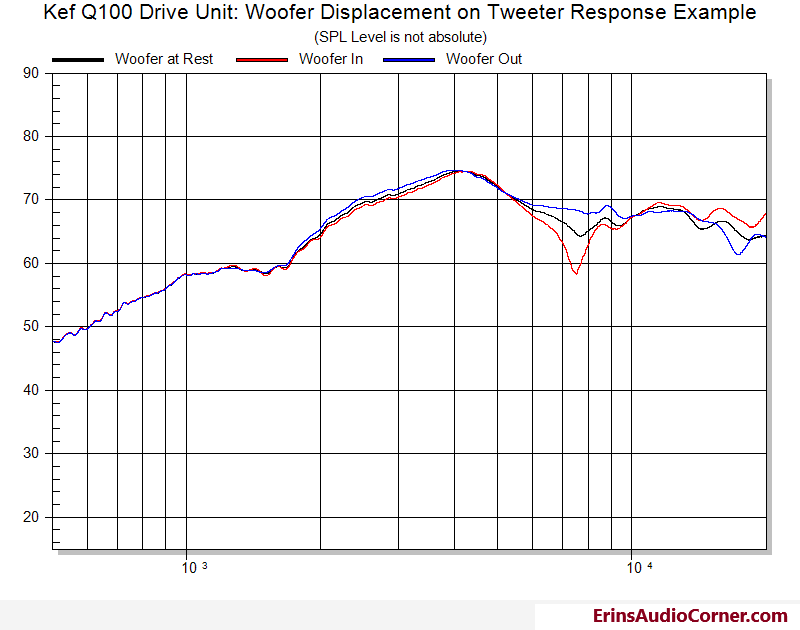
By the way, I my measurements show some diffraction features at 8kHz, which I though are resulting from a slight axial misalignment between the cone and the fixed part of the tweeter waveguide around the Tangerine waveguide. There's a small step between the cone and the center part in in the Q100 driver (which could be compensated with a small DC offset voltage
 ). How does it look in the R-series UniQ driver?
). How does it look in the R-series UniQ driver?Edit: See Erin's measurements with larger DC offset

Last edited:
I suppose that any FR anomaly should have a corresponding physical size aberration if there is an actual correlation. Such a small step as the one you describe - can it really contribute to anything below 20k? 8KHz has a WL of 42mm - for 20k it is 17mm. I wouldn't be my guess.
//
//
In my opinion it makes same measuring "DC features" - Q100 and R driver. Tweeter is same in both drivers, midbass VC diameter too.
Edit:
So I think it's about assembly of tweeter inside midbass cone, factory in China have to be accurate. 🙂 But system as is is well designed. Maybe you can try to disassembly and put it together again...? Can you make some detailed photos of tweeter/midbass part?
I have Q300 driver and I'm also planning project with it, but after hours of listennig Q300 with my custom DSP filters, I decided to replace the tweeter under tangerine WG. For my ears this 1" aluminium dome sounds like "cold and without spark", when you compare with fabric materials. This project of changing is running, as you can see in attached picture. Nowdays I have a lot more things to do (building a house), so it's going too slow, but it's going. 🙂
Edit:
So I think it's about assembly of tweeter inside midbass cone, factory in China have to be accurate. 🙂 But system as is is well designed. Maybe you can try to disassembly and put it together again...? Can you make some detailed photos of tweeter/midbass part?
I have Q300 driver and I'm also planning project with it, but after hours of listennig Q300 with my custom DSP filters, I decided to replace the tweeter under tangerine WG. For my ears this 1" aluminium dome sounds like "cold and without spark", when you compare with fabric materials. This project of changing is running, as you can see in attached picture. Nowdays I have a lot more things to do (building a house), so it's going too slow, but it's going. 🙂
Attachments
Last edited:
I suppose that any FR anomaly should have a corresponding physical size aberration if there is an actual correlation. Such a small step as the one you describe - can it really contribute to anything below 20k? 8KHz has a WL of 42mm - for 20k it is 17mm. I wouldn't be my guess.
//
So based on this logic features smaller than 17mm are irrelevant in loudspeaker design? I would say that discontinuity in the acoustic impedance (caused by the step) causes diffraction even though the step size is smaller than the corresponding wavelength. In this case the diameter of the structure is around 50mm (afair), which matches with the wavelength range
In my opinion it makes same measuring "DC features" - Q100 and R driver. Tweeter is same in both drivers, midbass VC diameter too.
Edit:
So I think it's about assembly of tweeter inside midbass cone, factory in China have to be accurate. 🙂 But system as is is well designed. Maybe you can try to disassembly and put it together again...?
I have Q300 driver and I'm also planning project with it, but after hours of listennig Q300 with my custom DSP filters, I decided to replace the tweeter under tangerine WG. For my ears this 1" aluminium dome sounds like "cold and without spark", when you compare with fabric materials. This project of changing is running, as you can see in attached picture. Nowdays I have a lot more things to do (building a house), so it's going too slow, but it's going. 🙂
I bet that a small step between the rest position of the cone and the center part of the driver was not considered a problem in a 2-way design like q100, since bass frequencies cause significant cone movement anyway. Perhaps this is different in the R-series driver. At least the spectrum looks different in that range.
Very interesting stuff with the tweeter
 Please keep us updated.
Please keep us updated.
Last edited:
So based on this logic features smaller than 17mm are irrelevant in loudspeaker design? I would say that discontinuity in the acoustic impedance (caused by the step) causes diffraction even though the step size is smaller than the corresponding wavelength. In this case the diameter of the structure is around 50mm (afair), which matches with the wavelength range
Probably WL of 1/2 and 1/4 is in play also but to lesser extent.
The diameter is an other player than the step itself and its size really matter for other reasons. We where talking about a ridge/step, about what, 1mm or less?
//
.... Nowdays I have a lot more things to do (building a house), so it's going too slow, but it's going. 🙂
Hahaha... Very soon i'm hoping to do the same - trying to buy me piece of land i like.
Slow but steady is a way of life.
Loving the tweeter mod you're doing. Which tweeter will you be using ?
By the way, I my measurements show some diffraction features at 8kHz, which I though are resulting from a slight axial misalignment between the cone and the fixed part of the tweeter waveguide around the Tangerine waveguide. There's a small step between the cone and the center part in in the Q100 driver (which could be compensated with a small DC offset voltage). How does it look in the R-series UniQ driver?
Edit: See Erin's measurements with larger DC offset
Surprisingly big change on the 8kHz, roughly 10dB! I agree that a small gap would hardly affect this low a frequency because being acoustically very small feature but never know, especially since the tweeter rim is all around the tweeter. People report small gap between tweeter frame and baffle to cause diffraction effects.
I would think another explanation / way to look at it could be that the waveguide profile changes enough to cause a discontinuity and the "mouth reflection" changes or some reflections at the tweeter rim gets generated. Reasoning from the fact that same ~3mm obstacle has different effect for in and out position it is not the gap itself that makes the dip but discontinuity/feature it makes to the waveguide profile. Very interesting that the effect is more dramatic with woofer in position than out. Is the wavelength related to the tweeter rim diameter?
You should try the DC offset trick for fun at least, I expect it to work since you limit the excursion of the coaxial by adding woofers, it might very well stay at the positive offset all the time, at least on casual listening. Make a battery + switch assembly so you can toggle the offset realtime and listen if there is audible difference?😀 Is there other coaxial drivers that account this in the construct so that the cone never goes behind the tweeter plane?
Anyway, pretty dramatic looking change due to cone movement. One would really want to miminize the cone movement of a coaxial driver.
Last edited:
Looking at Erins site a bit closer its a really big impact on the woofer position. Wow. It must be the actual phase situation wrt. to the baffle (bass cone) that changes and makes for the "suck out"... One really want to indeed. But its not the ridge itself - I'm quite sure about that.
//
//
Last edited:
Which tweeter will you be using ?
looks like a Peerless OX20SC00 in the rendered image 🙂
Here is small study made by member gaga in augerpro waveguide thread, where the recess of tweeter in relation the waveguide throat is inspected. Open source Waveguides for CNC & 3D printing!
It looks like a coaxial would modulate the high dispersion somewhat even with small excursion. I expect finding a good DC offset would improve the Q100 driver. If any of tgis was audible, I have no idea 😀
It looks like a coaxial would modulate the high dispersion somewhat even with small excursion. I expect finding a good DC offset would improve the Q100 driver. If any of tgis was audible, I have no idea 😀
Zvu:
BTW How to do quotation right? 😀
Whish you good luck, land prices in Czech rep. are really expensive, moreover, when it's near the city. And also in covid times, prices of buildig materials growing fast...
Tweeter is Peerless OX20SC00-04, stv you're right. It's only 3/4" but I hope it will act good in midbass cone profile. Maybe mesurements shows unexpected problems. I would like to simulate TW in this specific conditions to avoid trial-and-error method. 🙂
Hahaha... Very soon i'm hoping to do the same - trying to buy me piece of land i like.
Slow but steady is a way of life.
Loving the tweeter mod you're doing. Which tweeter will you be using ?
BTW How to do quotation right? 😀
Whish you good luck, land prices in Czech rep. are really expensive, moreover, when it's near the city. And also in covid times, prices of buildig materials growing fast...
Tweeter is Peerless OX20SC00-04, stv you're right. It's only 3/4" but I hope it will act good in midbass cone profile. Maybe mesurements shows unexpected problems. I would like to simulate TW in this specific conditions to avoid trial-and-error method. 🙂
Zvu:
BTW How to do quotation right? 😀
Hith the quotation mark untill it is red, and then hit "reply".

STV has a sharp eye 🙂
I'll allow myself some freedom to try to predict possible problems with tweeter modification.
Kef dome and inner curve of tangerine phase plug are following each other closely. Distance between dome and tangerine part is critical to get right to avoid cancelations. I'd pay close attention to that.
Last edited:
Surprisingly big change on the 8kHz, roughly 10dB! I agree that a small gap would hardly affect this low a frequency because being acoustically very small feature but never know, especially since the tweeter rim is all around the tweeter. People report small gap between tweeter frame and baffle to cause diffraction effects.
I would think another explanation / way to look at it could be that the waveguide profile changes enough to cause a discontinuity and the "mouth reflection" changes or some reflections at the tweeter rim gets generated. Reasoning from the fact that same ~3mm obstacle has different effect for in and out position it is not the gap itself that makes the dip but discontinuity/feature it makes to the waveguide profile. Very interesting that the effect is more dramatic with woofer in position than out. Is the wavelength related to the tweeter rim diameter?
You should try the DC offset trick for fun at least, I expect it to work since you limit the excursion of the coaxial by adding woofers, it might very well stay at the positive offset all the time, at least on casual listening. Make a battery + switch assembly so you can toggle the offset realtime and listen if there is audible difference?😀 Is there other coaxial drivers that account this in the construct so that the cone never goes behind the tweeter plane?
Anyway, pretty dramatic looking change due to cone movement. One would really want to miminize the cone movement of a coaxial driver.
Looking at Erins site a bit closer its a really big impact on the woofer position. Wow. It must be the actual phase situation wrt. to the baffle (bass cone) that changes and makes for the "suck out"... One really want to indeed. But its not the ridge itself - I'm quite sure about that.
//
I think we are on the same page. I just misinterpreted TNT's first comment as a more blunt statement indicating that subwavelength features don't matter.
Here's the measurement data I posted in message #86 for the Q100 driver on baffle with and without the additional 3D printed waveguide. Clearly the 8kHz feature is not because of the driver alone.
tmuikku, measuring the tweeter response for different (low voltage) DC offsets would indeed be an interesting experiment! Perhaps something for the holidays if the neighbors terrorize me with christmas songs😀
Zvu:
BTW How to do quotation right? 😀
Whish you good luck, land prices in Czech rep. are really expensive, moreover, when it's near the city. And also in covid times, prices of buildig materials growing fast...
Tweeter is Peerless OX20SC00-04, stv you're right. It's only 3/4" but I hope it will act good in midbass cone profile. Maybe mesurements shows unexpected problems. I would like to simulate TW in this specific conditions to avoid trial-and-error method. 🙂
I posted some simulation results for a similar tweeter in the WG formed by the mid cone somewhere on the very first pages of this thread. (post #26) The results were not very promising in comparison with a dome tweeter without a radiating surround, mainly because of a very pronounced on-axis dip. The simulations were not very comprehensive, though. Anyway, this is a issue which can be quite easily investigated using Ath and ABEC in circular symmetric geometry. Perhaps you could play with some additional 3D-printable structures for covering the dome surround?
- Home
- Loudspeakers
- Multi-Way
- 3-way active standmounts with coax upper end & Other UniQ adventures
